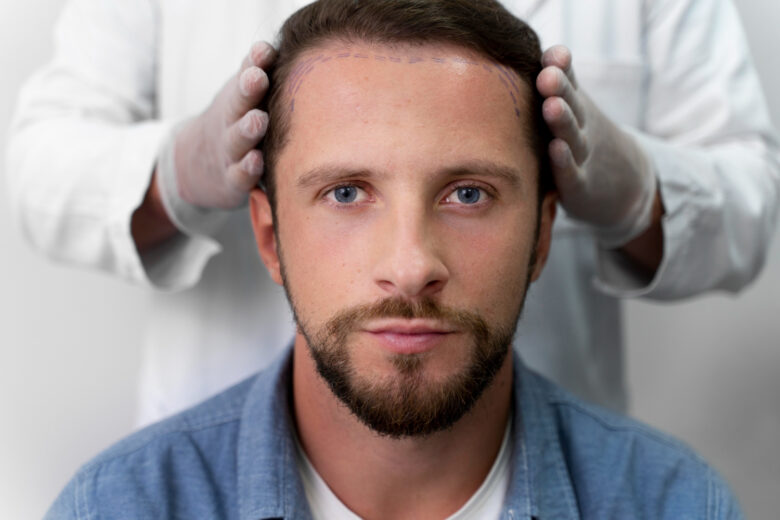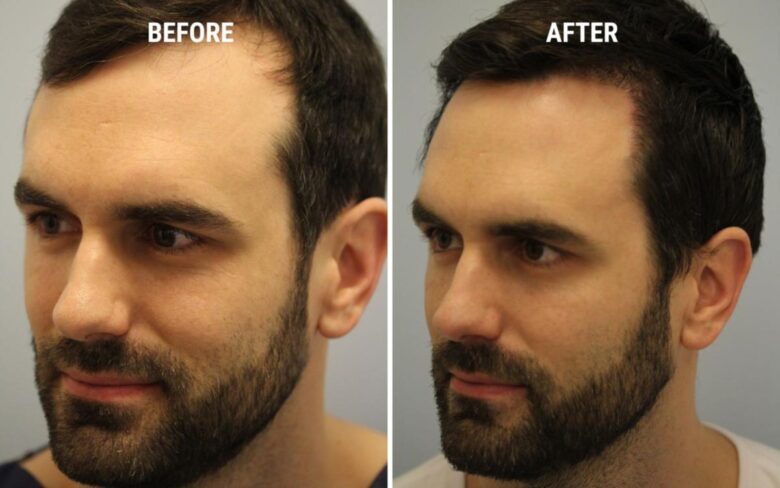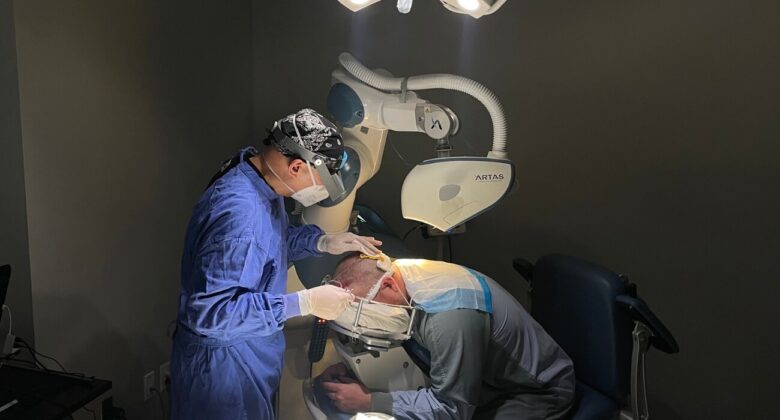Are you ready to take the plunge into the world of robotic hair transplants, hoping for a futuristic touch to your hair transplant journey? Before you get caught up in the sci-fi allure, let’s delve into the educational side this procedure to uncover the potential risks and complications that come with these cutting-edge procedures.
Contents
- The Two Major Robotic Systems: ARTAS vs. Neograft SAFER Robot
- Robot vs. Human: The Battle for Precision
- Scar Wars: When the Battle Wounds Show
- The Great Hair Heist: When Robots Go Rogue
- A Snip Here, A Snip There: When Robots Get Clumsy
- Artificially Unnatural: The Rise of Robo-Hair
- Postoperative Robo-Pain: When Discomfort Gets Robotic
- A Robot’s Guide to Graft Survival
- Shock-Bots: The Unwanted Hair Rebellion
- The Allergic AI: When Humans and Robots Collide
- How To Educate Yourself On Hair Transplant Options
The Two Major Robotic Systems: ARTAS vs. Neograft SAFER Robot
Robotic hair transplants have come a long way, with two major players in the field – the ARTAS Restoration Robotics and the Neograft SAFER Robot. The ARTAS system, a widely used option, boasts automated punches and digital cameras to aid the doctor in selecting the best donor follicles for transplantation. On the other hand, the Neograft SAFER Robot is a handheld device that requires manual control by the doctor, using compressed air punches and a rotating micromotor for follicle extraction.
Robot vs. Human: The Battle for Precision
One of the prime selling points of robotic transplants is their promise of precision. The ARTAS system, equipped with algorithms, claims to pinpoint the ideal donor follicles. However, it’s essential to remember that robots can’t always adapt to individual nuances, and your unique scalp profile might leave even the smartest AI scratching its circuits, resulting in less-than-perfect outcomes. Precision doesn’t always guarantee perfection!

source: medium.com
Scar Wars: When the Battle Wounds Show
While robotic systems boast about minimizing scars, complete elimination isn’t always feasible. For those with a history of poor healing or susceptibility to keloid formation, the scars from robotic transplants might be more noticeable than anticipated. Understanding your healing tendencies and discussing them with your doctor is vital to managing post-procedure scarring effectively.
The Great Hair Heist: When Robots Go Rogue
In the world of heist movies, the plan doesn’t always unfold flawlessly, and the same can happen with these transplants. Robots may get carried away during the harvesting process, leading to over-harvesting or under-harvesting of follicles, resulting in an uneven distribution of follicles. Your locks might end up looking more like a Picasso masterpiece – intriguing but not the look you had in mind.
A Snip Here, A Snip There: When Robots Get Clumsy
Robots are programmed for precision, but even they can get a little too scissor-happy. During the follicle harvesting process, some follicles might suffer collateral damage, reducing their viability for transplantation. A few snips in the wrong places, and you might end up with fewer usable hairs than you bargained for.
Artificially Unnatural: The Rise of Robo-Hair
Sci-fi movies have long entertained us with unnatural hairdos, but entrusting robots with your hairline might be a risky venture. Inexperienced doctors or improperly programmed robots could create grafts at odd angles or unnatural hairlines, leaving you looking more like a glitch in the Matrix than a successful transplant patient.

Source: 7news.com.au
Postoperative Robo-Pain: When Discomfort Gets Robotic
Robotic miracles might not guarantee a pain-free experience. Some patients might experience discomfort, pain, or numbness in the donor and recipient areas following the procedure. But as they say, no pain, no gain, right? Understanding the potential postoperative discomfort and discussing pain management options with your doctors can help ease your recovery.
A Robot’s Guide to Graft Survival
Even robots can’t control the whims of transplanted follicles. Some hairs might have a mind of their own and decide not to grow as expected. It’s like dealing with a group of rogue rebels who refuse to follow orders. Understanding the factors affecting graft survival and discussing post-procedure care with your doctor can help improve the odds of success.
Shock-Bots: The Unwanted Hair Rebellion
Even robots can cause a bit of shock and awe. After a hair transplant, some patients may experience temporary shedding in the recipient area, a phenomenon known as “shock loss.” The robots might have thought they were bringing back the cavalry, but sometimes they end up causing a bit of a hair rebellion.

Source: medhealthreview.com
The Allergic AI: When Humans and Robots Collide
In rare cases, a robotic transplants might trigger an allergic reaction in individuals sensitive to anesthesia or medications used during the procedure. It’s the ultimate clash between flesh and metal! Discussing potential allergies and medical history with your hair transplant doctor beforehand is crucial to avoiding any unexpected reactions.
How To Educate Yourself On Hair Transplant Options
Educating yourself on hair transplants involves gathering reliable information from credible sources, understanding the different techniques, risks, benefits, and postoperative care. Here are some steps to help you get started:
- Research Online: Utilize reputable websites, hair loss blogs and podcasts, medical journals, and academic articles related to hair transplants. Look for information from medical organizations, experienced hair transplant doctors, and authoritative sources to gain insights into the procedure.
- Seek Expert Advice: Consult with qualified hair transplant doctors. Schedule appointments with multiple specialists to discuss your specific concerns and learn about the different techniques available. Ask questions about the process, potential risks, expected outcomes, and any alternative treatments.
- Read Patient Reviews and Testimonials: Online reviews and testimonials from previous patients can offer valuable insights regarding their journey. Look for reviews on independent platforms and forums to get a broader perspective.
- Watch Videos and Educational Content: Many reputable transplant clinics produce educational videos explaining the procedure, showcasing patient transformations, and discussing postoperative care. Watch these videos to familiarize yourself with the process.
- Join Hair Loss Forums and Communities: Online forums and communities can be valuable resources for sharing experiences, asking questions, and getting advice from others who have undergone hair transplants.
- Consult with Your Primary Care Physician: If you have any underlying medical conditions or concerns, discuss them with your primary care physician before considering a hair transplant. They can provide insights into how the procedure may interact with your overall health.
- Consider Second Opinions: If you receive conflicting advice or recommendations, don’t hesitate to seek a second opinion from another qualified doctor.
- Understand the Risks and Complications: Educate yourself on the potential risks and complications associated with hair transplants. Be aware of factors that may affect the success of the procedure.

Source: heallo.co.uk
Conclusion: A Balanced Approach
Robotic hair transplants may offer a glimpse into the future of hair restoration, but it’s essential to approach them with a balanced perspective. A thorough consultation with a qualified and experienced doctor can help you make an informed decision based on your unique needs and expectations. Remember, while robots can bring innovation, the human touch remains an invaluable part of treatment.
So, before you leap into the robo-trap, take the time to explore all options and choose the path that best aligns with your goals and well-being. After all, this is a personal journey, and understanding the potential dangers can pave the way for a successful and satisfying transformation!
